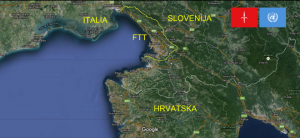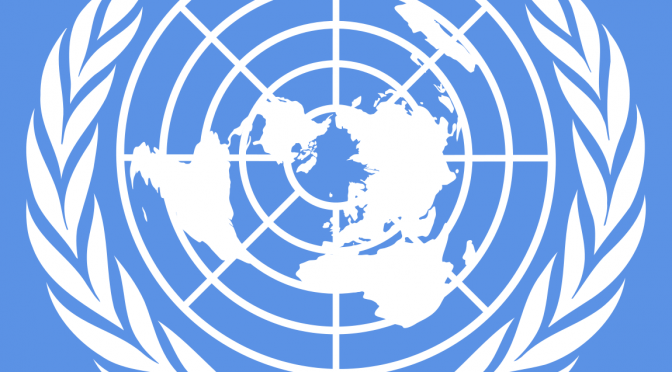by Silvia Verdoglia,
The Free Trieste Movement is the organization that acts for the re-establishment of legality in the Free Territory of Trieste, an independent, neutral and demilitarised State with an international Free Port, established on 15 September 1947. To archive this result, it bases all of its actions and documents (LINK) on the laws and international treaties in force, which are published here.
The Treaty of Peace with Italy:
One month before the signature of the Treaty of Peace with Italy, on 10 January 1947, with Resolution S/RES/16 (1947) the United Nations Security Council declared its role of guarantor of the integrity and independence of the Free Territory of Trieste-FTT. This document, in English and Franch, can be read and downloaded from the official website of the United Nations Organization: LINK
One month later, on 10 February 1947, at Parigi, the Treaty of Peace with Italy is signed, the attacking country and member of the Axis had surrendered without conditions at the end of World War II. The official version of the Treaty, in English, French and Russian, is published in the United Nations Treaty Series Volume 49: LINK
Article 21 rules the end of Italian sovereignty over Trieste at the coming into force of the Treaty: in accordance with this provision, on 15 September 1947 is proclaimed the creation of a new, independent State, the Free Territory of Trieste – FTT, with an international Free Port and under the expected provisional regime of Government (annex VI) in the expectation that the UNO Security Council appoints its Governor.
The first provisional Government of State is the Allied Military Government of the Free Territory of Trieste (AMG FTT) that announce the new, international status of the FTT with its first Proclamation: LINK
There are many Italian laws that ratify and recognize this territorial change, for a complete and updated list we suggest reading the documents of the Free Trieste Movement: LINK
The Memorandum of Understanding of London:
The AMG FTT remains the State Government of the FTT until 1954, the year in which the administration mandate is transformed from military to civil with the Memorandum of Understanding of London, which does also establish the succession of the Italian Government to the Allied Military Government in the main administration area of the FTT (zone A, which includes the capital city and the port) and the passage of the secondary administration zone (zone B) from the administration of the Yugoslav Military Government to that of the Government of State of the Socialist Federal Republic of Yugoslavia: LINK
Therefore, from that moment, both Governments have a double role: that of Government of State of their own Country and the role of provisional Government of State of the FTT on behalf of the United Nations.
The relations between all States involved – the Republic of Italy, the Free Territory of Trieste and the Socialist Federal Republic of Yugoslavia are still regulated by the Treaty of Peace and the laws or agreement that follow from it.
After the dissolution of the Socialist Federal Republic of Yugoslavia and, therefore, of its Government, the only part of the Memorandum of London in force is the one that bounds the Italian Government to administer the main zone of the FTT, that includes Trieste and its international Free Port.
In facts, the administration mandate prescribes to respect articles from 1 to 20 of Annex VIII of the Treaty of Peace, which establish and regulate the functioning of the international Free Port of Trieste, state corporation of the FTT that offers special and important fiscal advantages to many States in Europe and in the world.
This is confirmed by the legal translation of the document in Italian, drafted by the Court of Trieste as part of a trial in which Roberto Giurastante, founder of the Free Trieste Movement, raised an exception of jurisdiction. Out thanks to Roberto Giurastante for making the document available on his blog, „Ambiente e Legalità“ – „Environment and Legality“ (in Italian): LINK
The Italian-Yugoslav treaty, namely said „of Osimo“:
The version of the s.c. Treaty of Osimo of 1975 lodged at the UNO (1985) awaiting the ratification of the Secretariat, confirms that this is bilateral agreement between two States, therefore, that it does not establish obligations for the international community. For instance, bilateral agreements cannot amend multilateral treaties like the Treaty of Peace with Italy, not they can cause changes in sovereigny that involve third Countries, namely the Free Territory of Trieste.
This is why article 7 of the same 1975 Treaty confirms that it is the international obligations established under the Treaty of Peace of Paris to regulate the relations between the Republic of Italy and the Socialist Federal Republic of Yugoslavia (now dissolved), while the exercise of the temporary civil administration is exclusively a duty of their governments.
The copy of the Italian-Yugoslav treaty lodged at the United Nations is published here: LINK (see the „Note by the Secretariat“ for further information about the general principles described above).
The present-day Free Territory of Trieste:
As mentioned above, the only part of the Memorandum of understanding of London that is still in force revolves on the relations between the Italian Government and the main administration zone of the FTT: this is a consequence of the expiring of the mandate entrusted to the government of Yugoslavia over the secondary administration area at the ceasing of said government, as a consequence of the dissolution of the Socialist Federal Republic of Yugoslavia.
After the plebiscites and international recognition of the Republics of Slovenia and Croatia in their present-day borders (1991/92) consolidated also by the very Security Council with its resolutions for the admission of the two States in the UNO, S/RES/754 (1992) and S/RES/753 (1992) – LINK – the part of the Free Territory of Trieste that was previously entrusted to the ceased Yugoslav government came under the sovereignty of the two new independent States.
As for the legal principles regulating the international recognition of the passage of former administration zone B of the FTT to the sovereignty of State of Slovenia and Croatia by all signatory States of the previous Treaty of Peace, we suggest reading article 30.3 of the Vienna Convention on the Law of Treties, published on the UNO website: LINK
These are the legal principles establishing that the present-day Free Territory of Trieste corresponds with its main administration area, (the „Zone A“ established under the Memorandum of Understanding of London of 1954) consisting in the capital city, Trieste, the international Free Port and 5 smaller Municipalities nearby, currently under a provisional regime of Government, entrusted to Government of Italy.
In full accordance with the laws in force, the Free Trieste Movement has no claims against the Republics of Slovenia and Croazia or against any other State and its actions to re-establish legality in the current Free Territory of Trieste promote cooperation, peace and international stability.
On 23 October 2015, referring to the international protection of parts of territory and the protection of the civil populationof Palestina, the United Nations Security Council published an analisys of the Secretariat General on the matter and, at point V, the document confirms the unchanged status of the present-day Free Territory of Trieste – FTT.
Protocol number: S/2015/809 – LINK
The present-day Free Territory of Trieste (FTT – TLT – STO) and its neighbour States: Italy and Slovenia:

